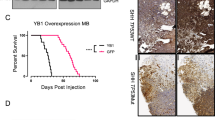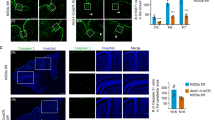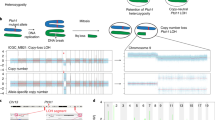Abstract
The tumor suppressive activities of the Kip-family of cyclin-dependent kinase (cdk) inhibitors often go beyond their role directly regulating the cell cycle. In this study, we show that p27 enhances Rad51 accumulation during repair of double-strand DNA breaks. Progression of platelet-derived growth factor (PDGF)-induced oligodendrogliomas was accelerated in mice lacking the cyclin–cdk binding activities of p27kip1. To understand how p27 deficiency contributes, cell lines were developed from RCAS–PDGF infection of nestin-tv-a brain progenitor cells in culture. p27 deficiency did not affect cell proliferation in early passage cell lines; however, the absence of p27 affected chromosomal stability. In p27-deficient cells, the activation of Atm and Chk2 and the accumulation of γ-H2AX was unaffected when compared with wild-type cells, and the number of phospho-histone H3 staining mitotic cells was decreased, consistent with G2/M checkpoint activation. However, the percentage of Rad51 foci-positive cells was decreased, and the kinase activity that targets the C-terminus of BRCA2, regulating BRCA2/Rad51 interactions, was increased in lysates derived from p27-deficient cells. Increased numbers of chromatid breaks in p27-deficient cells that adapted to the checkpoint were also observed. These findings suggest that Rad51-dependent repair of double-stranded breaks was hindered in p27-deficient cells, leading to chromosomal instability, a hallmark of cancers with poor prognosis.
This is a preview of subscription content, access via your institution
Access options
Subscribe to this journal
Receive 50 print issues and online access
$259.00 per year
only $5.18 per issue
Buy this article
- Purchase on Springer Link
- Instant access to full article PDF
Prices may be subject to local taxes which are calculated during checkout






Similar content being viewed by others
References
Anantha RW, Vassin VM, Borowiec JA . (2007). Sequential and synergistic modification of human RPA stimulates chromosomal DNA repair. J Biol Chem 282: 35910–35923.
Avilion AA, Nicolis SK, Pevny LH, Perez L, Vivian N, Lovell-Badge R . (2003). Multipotent cell lineages in early mouse development depend on SOX2 function. Genes Dev 17: 126–140.
Aylon Y, Liefshitz B, Kupiec M . (2004). The CDK regulates repair of double-strand breaks by homologous recombination during the cell cycle. EMBOJ 23: 4868–4875.
Bartkova J, Horejsi Z, Koed K, Kramer A, Tort F, Zieger K et al. (2005). DNA damage response as a candidate anti-cancer barrier in early human tumorigenesis. Nature 434: 864–870.
Becher OJ, Hambardzumyan D, Fomchenko EI, Momota H, Mainwaring L, Bleau AM et al. (2008). Gli activity correlates with tumor grade in platelet-derived growth factor-induced gliomas. Cancer Res 68: 2241–2249.
Blain SW, Scher HI, Cordon-Cardo C, Koff A . (2003). p27 as a target for cancer therapeutics. Cancer Cell 3: 111–115.
Carneiro C, Jiao MS, Hu M, Shaffer D, Park M, Pandolfi PP et al. (2003). p27 deficiency desensitizes Rb-/- cells to signals that trigger apoptosis during pituitary tumor development. Oncogene 22: 361–369.
Casaccia-Bonnefil P, Tikoo R, Kiyokawa H, Friedrich V, Chao Jr MV, Koff A . (1997). Oligodendrocyte precursor differentiation is perturbed in the absence of the cyclin-dependent kinase inhibitor p27Kip1. Genes Dev 11: 2335–2346.
Cavalla P, Piva R, Bortolotto S, Grosso R, Cancelli I, Chio A et al. (1999). p27/kip1 expression in oligodendrogliomas and its possible prognostic role. Acta Neuropathol (Berl) 98: 629–634.
Chibazakura T, McGrew SG, Cooper JA, Yoshikawa H, Roberts JM . (2004). Regulation of cyclin-dependent kinase activity during mitotic exit and maintenance of genome stability by p21, p27, and p107. Proc Natl Acad Sci USA 101: 4465–4470.
Cipriano SC, Chen L, Burns KH, Koff A, Matzuk MM . (2001). Inhibin and p27 interact to regulate gonadal tumorigenesis. Mol Endocrinol 15: 985–996.
Dai C, Celestino JC, Okada Y, Louis DN, Fuller GN, Holland EC . (2001). PDGF autocrine stimulation dedifferentiates cultured astrocytes and induces oligodendrogliomas and oligoastrocytomas from neural progenitors and astrocytes in vivo. Genes Dev 15: 1913–1925.
Di Cristofano A, De Acetis M, Koff A, Cordon-Cardo C, Pandolfi PP . (2001). Pten and p27KIP1 cooperate in prostate cancer tumor suppression in the mouse. Nat Genet 27: 222–224.
Di Rocco F, Carroll RS, Zhang J, Black PM . (1998). Platelet-derived growth factor and its receptor expression in human oligodendrogliomas. Neurosurgery 42: 341–346.
Doetsch F, Garcia-Verdugo JM, Alvarez-Buylla A . (1997). Cellular composition and three-dimensional organization of the subventricular germinal zone in the adult mammalian brain. J Neurosci 17: 5046–5061.
Doetsch F, Verdugo JM, Caille I, Alvarez-Buylla A, Chao MV, Casaccia-Bonnefil P . (2002). Lack of the cell-cycle inhibitor p27Kip1 results in selective increase of transit-amplifying cells for adult neurogenesis. J Neurosci 22: 2255–2264.
Durand B, Fero ML, Roberts JM, Raff MC . (1998). p27Kip1 alters the response of cells to mitogen and is part of a cell-intrinsic timer that arrests the cell cycle and initiates differentiation. Curr Biol 8: 431–440.
Esashi F, Christ N, Gannon J, Liu Y, Hunt T, Jasin M et al. (2005). CDK-dependent phosphorylation of BRCA2 as a regulatory mechanism for recombinational repair. Nature 434: 598–604.
Fero ML, Randel E, Gurley KE, Roberts JM, Kemp CJ . (1998). The murine gene p27Kip1 is haplo-insufficient for tumour suppression. Nature 396: 177–180.
Fero ML, Rivkin M, Tasch M, Porter P, Carow CE, Firpo E et al. (1996). A syndrome of multiorgan hyperplasia with features of gigantism, tumorigenesis, and female sterility in p27(Kip1)-deficient mice. Cell 85: 733–744.
Ferri AL, Cavallaro M, Braida D, Di Cristofano A, Canta A, Vezzani A et al. (2004). Sox2 deficiency causes neurodegeneration and impaired neurogenesis in the adult mouse brain. Development 131: 3805–3819.
Foster ER, Downs JA . (2005). Histone H2A phosphorylation in DNA double-strand break repair. FEBS J 272: 3231–3240.
Gibbs E, Pan ZQ, Niu H, Hurwitz J . (1996). Studies on the in vitro phosphorylation of HSSB-p34 and -p107 by cyclin-dependent kinases. Cyclin-substrate interactions dictate the efficiency of phosphorylation. J Biol Chem 271: 22847–22854.
Gorgoulis VG, Vassiliou LV, Karakaidos P, Zacharatos P, Kotsinas A, Liloglou T et al. (2005). Activation of the DNA damage checkpoint and genomic instability in human precancerous lesions. Nature 434: 907–913.
Haaf T, Golub EI, Reddy G, Radding CM, Ward DC . (1995). Nuclear foci of mammalian Rad51 recombination protein in somatic cells after DNA damage and its localization in synaptonemal complexes. Proc Natl Acad Sci USA 92: 2298–2302.
Holland EC . (2001). Progenitor cells and glioma formation. Curr Opin Neurol 14: 683–688.
Huertas P, Cortes-Ledesma F, Sartori AA, Aguilera A, Jackson SP . (2008). CDK targets Sae2 to control DNA-end resection and homologous recombination. Nature 455: 689–692.
Jin K, Mao XO, Batteur S, Sun Y, Greenberg DA . (2003). Induction of neuronal markers in bone marrow cells: differential effects of growth factors and patterns of intracellular expression. Exp Neurol 184: 78–89.
Kamiya M, Nakazato Y . (2002). The expression of cell cycle regulatory proteins in oligodendroglial tumors. Clin Neuropathol 21: 52–65.
Kiyokawa H, Kineman RD, Manova-Todorova KO, Soares VC, Hoffman ES, Ono M et al. (1996). Enhanced growth of mice lacking the cyclin-dependent kinase inhibitor function of p27(Kip1). Cell 85: 721–732.
Koff A . (2006). How to decrease p27Kip1 levels during tumor development. Cancer Cell 9: 75–76.
Korshunov A, Golanov A, Sycheva R . (2002). Immunohistochemical markers for prognosis of oligodendroglial neoplasms. J Neurooncol 58: 237–253.
Liu Y, Yeh N, Zhu XH, Leversha M, Cordon-Cardo C, Ghossein R et al. (2007). Somatic cell type specific gene transfer reveals a tumor-promoting function for p21(Waf1/Cip1). EMBOJ 26: 4683–4693.
Martins CP, Berns A . (2002). Loss of p27(Kip1) but not p21(Cip1) decreases survival and synergizes with MYC in murine lymphomagenesis. EMBOJ 21: 3739–3748.
Musgrove EA, Davison EA, Ormandy CJ . (2004). Role of the CDK inhibitor p27 (Kip1) in mammary development and carcinogenesis: insights from knockout mice. J Mammary Gland Biol Neoplasia 9: 55–66.
Nakayama K, Ishida N, Shirane M, Inomata A, Inoue T, Shishido N et al. (1996). Mice lacking p27(Kip1) display increased body size, multiple organ hyperplasia, retinal dysplasia, and pituitary tumors. Cell 85: 707–720.
Park MS, Rosai J, Nguyen HT, Capodieci P, Cordon-Cardo C, Koff A . (1999). p27 and Rb are on overlapping pathways suppressing tumorigenesis in mice. Proc Natl Acad Sci USA 96: 6382–6387.
Payne SR, Zhang S, Tsuchiya K, Moser R, Gurley KE, Longton G et al. (2008). p27kip1 deficiency impairs G2/M arrest in response to DNA damage, leading to an increase in genetic instability. Mol Cell Biol 28: 258–268.
Porter PL, Malone KE, Heagerty PJ, Alexander GM, Gatti LA, Firpo EJ et al. (1997). Expression of cell-cycle regulators p27Kip1 and cyclin E, alone and in combination, correlate with survival in young breast cancer patients. Nat Med 3: 222–225.
Powell SN, Bindra RS . (2009). Targeting the DNA damage response for cancer therapy. DNA Repair (Amst) 8: 1153–1165.
Raderschall E, Golub EI, Haaf T . (1999). Nuclear foci of mammalian recombination proteins are located at single-stranded DNA regions formed after DNA damage. Proc Natl Acad Sci USA 96: 1921–1926.
Sarkaria JN, Busby EC, Tibbetts RS, Roos P, Taya Y, Karnitz LM et al. (1999). Inhibition of ATM and ATR kinase activities by the radiosensitizing agent, caffeine. Cancer Res 59: 4375–4382.
Shaffer DR, Viale A, Ishiwata R, Leversha M, Olgac S, Manova K et al. (2005). Evidence for a p27 tumor suppressive function independent of its role regulating cell proliferation in the prostate. Proc Natl Acad Sci USA 102: 210–215.
Sherr CJ, Roberts JM . (1995). Inhibitors of mammalian G1 cyclin-dependent kinases. Genes Dev 9: 1149–1163.
Sherr CJ, Roberts JM . (1999). CDK inhibitors: positive and negative regulators of G1-phase progression. Genes Dev 13: 1501–1512.
Shih AH, Dai C, Hu X, Rosenblum MK, Koutcher JA, Holland EC . (2004). Dose-dependent effects of platelet-derived growth factor-B on glial tumorigenesis. Cancer Res 64: 4783–4789.
Soos TJ, Kiyokawa H, Yan JS, Rubin MS, Giordano A, DeBlasio A et al. (1996). Formation of p27-CDK complexes during the human mitotic cell cycle. Cell Growth Differ 7: 135–146.
Spruck CH, Won KA, Reed SI . (1999). Deregulated cyclin E induces chromosome instability. Nature 401: 297–300.
Strohmaier H, Spruck CH, Kaiser P, Won KA, Sangfelt O, Reed SI . (2001). Human F-box protein hCdc4 targets cyclin E for proteolysis and is mutated in a breast cancer cell line. Nature 413: 316–322.
Uhrbom L, Hesselager G, Nister M, Westermark B . (1998). Induction of brain tumors in mice using a recombinant platelet-derived growth factor B-chain retrovirus. Cancer Res 58: 5275–5279.
Uhrbom L, Holland EC . (2001). Modeling gliomagenesis with somatic cell gene transfer using retroviral vectors. J Neurooncol 53: 297–305.
Weinstock DM, Richardson CA, Elliott B, Jasin M . (2006). Modeling oncogenic translocations: distinct roles for double-strand break repair pathways in translocation formation in mammalian cells. DNA Repair (Amst) 5: 1065–1074.
Acknowledgements
We thank Travis Stracker, John Petrini, Yossi Shiloh, Yuhui Liu, Nancy Yeh, Daniel Ciznadija, Dolores Hambardzumyan, Oren Becher, Elena Fomchenko, and Robert Finney, Katia Manova, Lei Zhang, Kalyani Chadalavada, Margaret Leversha, Jan Hendrix and Diane Domingo. This research was supported by the US National Institutes of Health Grant CA96582 (to MR, AK and EH), CA89563 (to AK) and funds from The Golfers Against Cancer Foundation (to AK). Additional support was provided by an Institutional Core Grant to Memorial Sloan-Kettering Cancer Center.
Author information
Authors and Affiliations
Corresponding author
Additional information
Supplementary Information accompanies the paper on the Oncogene website (http://www.nature.com/onc)
Rights and permissions
About this article
Cite this article
See, W., Miller, J., Squatrito, M. et al. Defective DNA double-strand break repair underlies enhanced tumorigenesis and chromosomal instability in p27-deficient mice with growth factor-induced oligodendrogliomas. Oncogene 29, 1720–1731 (2010). https://doi.org/10.1038/onc.2009.465
Received:
Revised:
Accepted:
Published:
Issue Date:
DOI: https://doi.org/10.1038/onc.2009.465
Keywords
This article is cited by
-
The DNA Double-Strand Break Repair in Glioma: Molecular Players and Therapeutic Strategies
Molecular Neurobiology (2022)
-
Cip2a promotes cell cycle progression in triple-negative breast cancer cells by regulating the expression and nuclear export of p27Kip1
Oncogene (2017)
-
Novel piperazine core compound induces death in human liver cancer cells: possible pharmacological properties
Scientific Reports (2016)
-
Histone modification as a drug resistance driver in brain tumors ⁎
Oncology and Translational Medicine (2016)
-
Apoptotic effect of novel Schiff Based CdCl2(C14H21N3O2) complex is mediated via activation of the mitochondrial pathway in colon cancer cells
Scientific Reports (2015)



